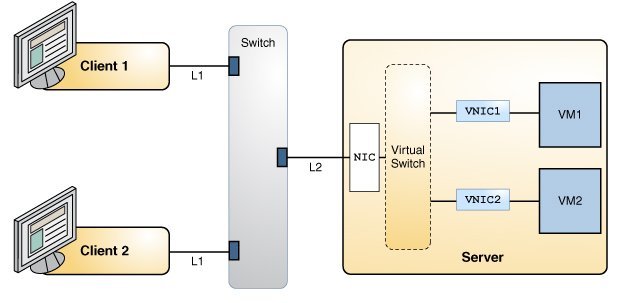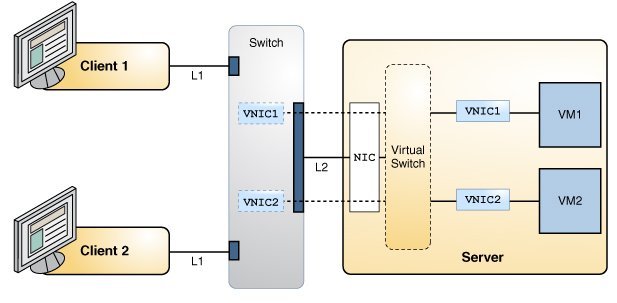Network and Server Efficiency Improvements by Using EVB
This section shows how server and network efficiency is increased through EVB.
Suppose that the server hosts two applications in a cloud environment.
-
Applications are hosted separate virtual machines (VM1 and VM2), each of which has its corresponding VNICs (VNIC1 and VNIC2, respectively).
-
Client 1 and Client 2 can access the applications.
-
VM1 and VM2 share the resources of the physical system and the bandwidth on link L2.
-
Clients connect to the switch through the link L1. The switch is connected to the NIC by using the link L2.
-
Predetermined SLA implements the following bandwidth usage on L2 for the VMs:
-
VM1 is running a high priority Transmission Control Protocol (TCP) service. VM1 has the maximum bandwidth limit of 8 Gbps.
-
VM2 is running a User Datagram Protocol (UDP) service that is not high priority. VM2 has the maximum bandwidth limit of 3 Gbps.
-
The following figure shows the applications hosted on a server.
Figure 12 Application Setup Without EVB

The following figure shows the same setup with EVB enabled:
Figure 13 Application Setup With EVB Enabled

Table compares server efficiency between a network setup without EVB and one with EVB enabled.
How to Install EVB
To use EVB with its default configuration, you simply install the EVB package.
Before You Begin
Ensure that your role has the appropriate rights profile to perform this procedure. See Using Rights Profiles to Perform Network Configuration.
-
Verify whether the EVB package is installed.
$ pkg info evb
-
If the EVB package is not installed, install the package.
$ pkg install evb
-
Verify whether the service is enabled.
$ svcs vdp
-
If the service is not enabled, enable the service.
$ svcadm enable vdp
The default EVB configuration is automatically enabled after EVB package installation. By accepting the default EVB configuration, the system can immediately exchange the information about any VNIC that you configure on the system with the external switch.
See Also